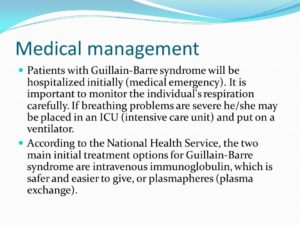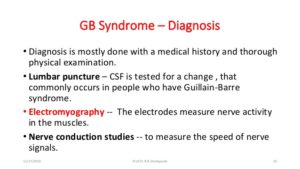
Medical Management: Patients with Guillain-Barre syndrome will be hospitalized initially (medical emergency). It is important to monitor the individual s respiration carefully. If breathing problems are severe he/she may be placed in an ICU (intensive care unit) and put on a ventilator. According to the National Health Service, the two main initial treatment options for Guillain-Barre syndrome are intravenous immunoglobulin, which is safer and easier to give, or plasmapheres (plasma exchange).
How is Guillain-Barré syndrome diagnosed?
The initial signs and symptoms of GBS are varied and there are several disorders with similar symptoms. Therefore, doctors may find it difficult to diagnose GBS in its earliest stages.
Physicians will note whether the symptoms appear on both sides of the body (the typical finding in Guillain-Barré syndrome) and the speed with which the symptoms appear (in other disorders, muscle weakness may progress over months rather than days or weeks). In GBS, deep tendon reflexes in the legs, such as knee jerks, are usually lost. Reflexes may also be absent in the arms. Because the signals traveling along the nerve are slow, a nerve conduction velocity test (NCV, which measures the nerve’s ability to send a signal) can provide clues to aid the diagnosis. There is a change in the cerebrospinal fluid that bathes the spinal cord and brain in people with GBS. Researchers have found the fluid contains more protein than usual but very few immune cells (measured by white blood cells). Therefore, a physician may decide to perform a spinal tap or lumbar puncture to obtain a sample of spinal fluid to analyze. In this procedure, a needle is inserted into the person’s lower back and a small amount of cerebrospinal fluid is withdrawn from the spinal cord. This procedure is usually safe, with rare complications.
Key diagnostic findings include:
- Recent onset, within days to at most four weeks of symmetric weakness, usually starting in the legs
- Abnormal sensations such as pain, numbness, and tingling in the feet that accompany or even occur before weakness
- Absent or diminished deep tendon reflexes in weak limbs
- Elevated cerebrospinal fluid protein without elevated cell count.This may take up to 10 days from onset of symptoms to develop.
- Abnormal nerve conduction velocity findings, such as slow signal conduction
- Sometimes, a recent viral infection or diarrhea.
How is Guillain-Barré treated?
There is no known cure for Guillain-Barré syndrome. However, some therapies can lessen the severity of the illness and shorten recovery time. There are also several ways to treat the complications of the disease.
Because of possible complications of muscle weakness, problems that can affect any paralyzed person (such as pneumonia or bed sores) and the need for sophisticated medical equipment, individuals with Guillain-Barré syndrome are usually admitted and treated in a hospital’s intensive care unit.
Acute care
There are currently two treatments commonly used to interrupt immune-related nerve damage. One is plasma exchange (PE, also called plasmapheresis); the other is high-dose immunoglobulin therapy (IVIg). Both treatments are equally effective if started within two weeks of onset of GBS symptoms, but immunoglobulin is easier to administer. Using both treatments in the same person has no proven benefit.
In the process of plasma exchange, a plastic tube called a catheter is inserted into the person’s veins, through which some blood is removed. The blood cells from the liquid part of the blood (plasma) are extracted and returned to the person. This technique seems to reduce the severity and duration of the Guillain-Barré episode. Plasma contains antibodies and PE removes some plasma; PE may work by removing the bad antibodies that have been damaging the nerves.
Immunoglobulins are proteins that the immune system naturally makes to attack infecting organisms. IVIg therapy involves intravenous injections of these immunoglobulins. The immunoglobulins are developed from a pool of thousands of normal donors. When IVIg is given to people with GBS, the result can be a lessening of the immune attack on the nervous system. The IVIg can also shorten recovery time. Investigators believe this treatment also lowers the levels or effectiveness of antibodies that attack the nerves by both “diluting” them with non-specific antibodies and providing antibodies that bind to the harmful antibodies and take them out of commission.
Miller-Fisher syndrome that is a rare, acquired nerve disease that is considered to be a variant of Guillain-Barré syndrome, is also treated with plasmapheresis and IVIg.
Anti-inflammatory steroid hormones called corticosteroids have also been tried to reduce the severity of Guillain-Barré syndrome. However, controlled clinical trials have demonstrated that this treatment is not effective.
Supportive care is very important to address the many complications of paralysis as the body recovers and damaged nerves begin to heal. Respiratory failure can occur in GBS, so close monitoring of a person’s breathing should be instituted initially. Sometimes a mechanical ventilator is used to help support or control breathing. The autonomic nervous system (that regulates the functions of internal organs and some of the muscles in the body) can also be disturbed, causing changes in heart rate, blood pressure, toileting, or sweating. Therefore, the person should be put on a heart monitor or equipment that measures and tracks body function. Occasionally GBS-related nerve damage can lead to difficulty handling secretions in the mouth and throat. In addition to the person choking and/or drooling, secretions can fall into the airway and cause pneumonia.
Rehabilitative care
As individuals begin to improve, they are usually transferred from the acute care hospital to a rehabilitation setting. Here, they can regain strength, receive physical rehabilitation and other therapy to resume activities of daily living, and prepare to return to their pre-illness life.
Complications in GBS can affect several parts of the body. Often, even before recovery begins, caregivers may use several methods to prevent or treat complications. For example, a therapist may be instructed to manually move and position the person’s limbs to help keep the muscles flexible and prevent muscle shortening. Injections of blood thinners can help prevent dangerous blood clots from forming in leg veins. Inflatable cuffs may also be placed around the legs to provide intermittent compression. All or any of these methods helps prevent blood stagnation and sludging (the buildup of red blood cells in veins, which could lead to reduced blood flow) in the leg veins. Muscle strength may not return uniformly; some muscles that get stronger faster may tend to take over a function that weaker muscles normally perform—called substitution. The therapist should select specific exercises to improve the strength of the weaker muscles so their original function can be regained.
Occupational and vocational therapy help individuals learn new ways to handle everyday functions that may be affected by the disease, as well as work demands and the need for assistive devices and other adaptive equipment and technology.
What is the long-term outlook for those with GBS?
Guillain-Barré syndrome can be a devastating disorder because of its sudden and rapid, unexpected onset of weakness—and usually actual paralysis. Fortunately, 70% of people with GBS eventually experience full recovery. With careful intensive care and successful treatment of infection, autonomic dysfunction and other medical complications, even those individuals with respiratory failure usually survive.
Typically, the point of greatest weakness occurs days to at most 4 weeks after the first symptoms occur. Symptoms then stabilize at this level for a period of days, weeks, or, sometimes months. Recovery, however, can be slow or incomplete. The recovery period may be as little as a few weeks up to a few years. Some individuals still report ongoing improvement after 2 years. About 30 percent of those with Guillain-Barré have residual weakness after 3 years. About 3 percent may suffer a relapse of muscle weakness and tingling sensations many years after the initial attack. About 15 percent of individuals experience long-term weakness; some may require ongoing use of a walker, wheelchair, or ankle support. Muscle strength may not return uniformly.
Ongoing fatigue, pain, and other annoying sensations can sometimes be troublesome. Fatigue is best handled by pacing activities and providing time for rest when fatigue sets in. Those with Guillain-Barré syndrome face not only physical difficulties, but emotionally painful periods as well. It is often extremely difficult for individuals to adjust to sudden paralysis and dependence on others for help with routine daily activities. Individuals sometimes need psychological counseling to help them adapt. Support groups can often ease emotional strain and provide valuable information.
